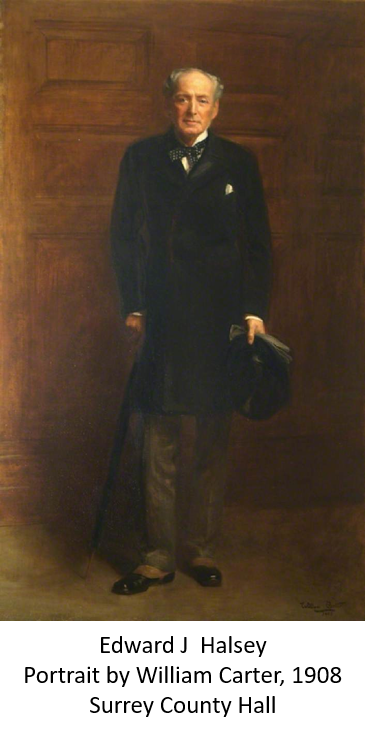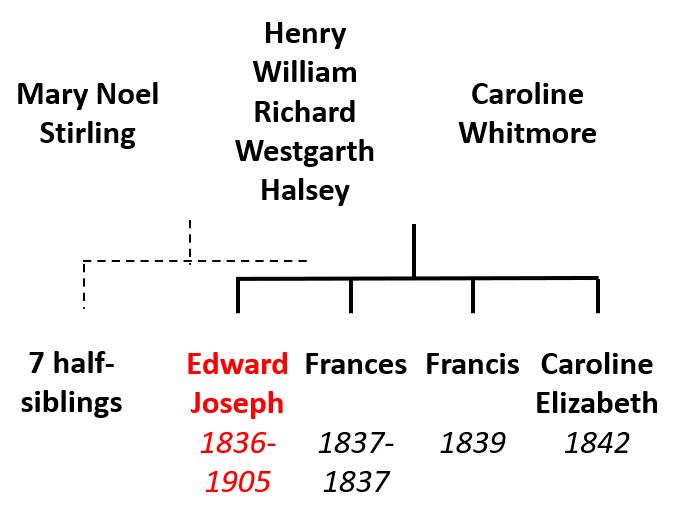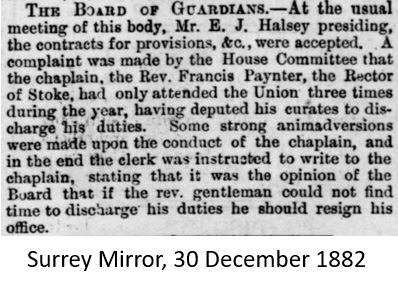edward joseph halsey
 Subject Name: Edward Joseph Halsey (b 1836 – d 1905)
Subject Name: Edward Joseph Halsey (b 1836 – d 1905)
Researchers: Margaret Rose and Heather Turner
MEMBER OF THE GUILDFORD UNION BOARD OF GUARDIANS
FOR PIRBRIGHT
April 1877 – April 1884
CHAIRMAN OF GUILDFORD UNION BOARD OF GUARDIANS
May 1880 – April 1884
First experience of local administration at Guildford Union for prominent local businessman
Edward Joseph Halsey, was born into a wealthy, influential family who had owned Henley Park,  near Normandy in Surrey from 1784 until the 1920’s. He had a long and varied life as a highly successful businessman and a prominent public servant. His first public office was as Chairman of the Guildford Union Board of Guardians, going on to serve as one of the first Chairmen of the Surrey County Council.
near Normandy in Surrey from 1784 until the 1920’s. He had a long and varied life as a highly successful businessman and a prominent public servant. His first public office was as Chairman of the Guildford Union Board of Guardians, going on to serve as one of the first Chairmen of the Surrey County Council.
Regardless of his wealth he was a man with a ‘social conscience’ and his life’s achievements bear witness to that.
Son of the Lord of the Manor of Pirbright
Edward was born on 28th February 1836 at Henley Park and baptised at the local parish church of St Peter’s Church, Ash. His parents were Henry William Richard Westgarth Halsey, Lord of the Manor of Pirbright and a major landowner, and his second wife Caroline née Whitmore, his first wife having passed away in 1834.
 As well as 5 half-sisters and 2 half-brothers from his father’s first marriage, Edward had three younger siblings, Frances, Francis and Caroline Elizabeth. All the children were baptised at St Peter’s, Ash. Edward’s sister Frances died age 6 weeks and was buried at St Michael and All Angels Church, Pirbright.
As well as 5 half-sisters and 2 half-brothers from his father’s first marriage, Edward had three younger siblings, Frances, Francis and Caroline Elizabeth. All the children were baptised at St Peter’s, Ash. Edward’s sister Frances died age 6 weeks and was buried at St Michael and All Angels Church, Pirbright.
Edward would have received a first-class education. In 1850 he won a scholarship to Durham Grammar School, where he boarded as a scholar, leaving in 1853 to go to Charterhouse School in London. Charterhouse School relocated to Godalming in 1872.
I n December 1864, 28-year-old Edward married Katherine Dalrymple
n December 1864, 28-year-old Edward married Katherine Dalrymple  Bircham in Westminster, London, a few days before her 25th birthday. Edward and Katherine lived at 103 Belgrave Road in Westminster, where their three sons were born.
Bircham in Westminster, London, a few days before her 25th birthday. Edward and Katherine lived at 103 Belgrave Road in Westminster, where their three sons were born.
In 1861, Edward had been working as a ‘clerk to an Havannah Merchant’, presumably dealing in Cuban cigars. On his sons’ baptism records he was noted as a ‘Merchant’ in his own right. He was clearly very successful in the business world, as he became Managing Director of the newly established London Bank of Commerce for ‘general mercantile exchange, and foreign banking operations’ in 1873.
In 1879, Edward became a Freeman of the City of London by virtue of being accepted into the Worshipful Company of (Wood) Turners, one of the oldest Livery Companies in the City of London. It was not uncommon for people to join Livery Companies that were not necessarily connected to their trade or occupation, as was the case with Edward, who gave his business as ‘Commission Merchant’. Edward may have been recommended or introduced, and may have viewed membership as a route to improve his ‘standing in society’. His application states he paid for the privilege.
Chairman of the Guildford Union Board of Guardians
Edward and his family moved out of London and back to Surrey in the mid-1870s, making their home at The Cottage, Pirbright. He continued as a merchant in the City, but was now looking towards public service. In April 1877 he joined the Guildford Union Board of Guardians as member for the parish of Pirbright, became a Justice of the Peace for the County of Surrey in 1880, and a ‘County Magistrate’.
In May 1880, Edward was elected as Chairman  of the Board of Guardians, following the resignation of the Hon. Francis Scott, who had served for nearly twenty years.
of the Board of Guardians, following the resignation of the Hon. Francis Scott, who had served for nearly twenty years.
Edward was elected after a vote, with a majority of three, defeating the Board of Guardian member for Godalming Urban and Vice-Chairman Edward Eager.
As Chairman of the Guildford Union Board of Guardians, Edward would need to lead, direct and guide his fellow Board members, as he held overall responsibility for the Union and its funds. His background as a magistrate would have given him the necessary grounding in the laws of the times.
Edward was very actively involved with the governance of the Workhouse and the welfare of the inmates. He was appointed to the Assessment Committee (responsible for the valuation of properties for rates, and appeals against valuations), School Attendance Committee, Finance Committee, and (Work)House & Land Committee.
He worked closely with his Board of Guardians colleague Miss Augusta Spottiswoode on the emigration of workhouse children to Canada. The Board was very much of the opinion that the children would benefit, ‘make better members of society’ and stand a better chance of earning a living in Canada. In June 1883, when considering the emigration of workhouse children Alice and James Hart, Horace Fowler when done and Fanny Monk, speaking in favour Edward said that he ‘knew from personal experience in Canada that the children were exceedingly well looked after, and much sought for. They had good homes, and a much better prospect than they could have in this country’. However, he did admit ‘It was an experiment on the part of the Board, but it had been thoroughly well thought out’, and that it was a cost saving for the Union.
 As well as being sympathetic, Edward could be strict at times, for example refusing to allow able-bodied paupers to enjoy a Christmas dinner if they had been admitted to the Workhouse within a couple of weeks of Christmas. He also reprimanded the Chaplain when done for changing the time of some of the services without permission from the Board, and for not visiting the Union frequently enough.
As well as being sympathetic, Edward could be strict at times, for example refusing to allow able-bodied paupers to enjoy a Christmas dinner if they had been admitted to the Workhouse within a couple of weeks of Christmas. He also reprimanded the Chaplain when done for changing the time of some of the services without permission from the Board, and for not visiting the Union frequently enough.
At the same time as he became Chairman of the Board of Guardians, Edward also became Chairman of The Rural Sanitary Authority, following the resignation of the Hon. Francis Scott from that position as well.
Chairman of The Rural Sanitary Authority, following the resignation of the Hon. Francis Scott from that position as well.
These two appointments went hand in hand, with the Rural Sanitary Committee holding its meetings in the Board Room at the Guildford Union Workhouse too.
After four years in those positions, in March 1884 Edward somewhat unexpectedly stood down as Chairman of the Board of Guardians and of the Rural Sanitary Committee, explaining that he was not seeking re-election because ‘The many claims upon my spare time, together with considerations of health, render it impossible for me to devote myself to the public service as much as I have done in the past, and as much as seems to me necessary for efficiently carrying out the duties of chairman of the Board of Guardians and the Rural Sanitary Authority of this important Union’.
He did not however sever all ties, as he remained as an ex-officio member of the House & Land and Finance Committees until April 1888, and on the Assessment and School Attendance Committees, until March 1890.
Edward’s successor was John Charles Ramsden of Busbridge Hall, Godalming, who with his wife had founded Busbridge Church dedicated in 1867.
Elected to the first Surrey County Council as Councillor for Worplesdon
Six months after standing down as Chairman of the Board of Guardians, in October 1888, Edward announced his intention to stand for election as County Councillor for the Worplesdon Electoral Division of Guildford, which included Pirbright. Elected County Councils had been established under the Local Government Act of 1888, taking over the functions previously carried by unelected magistrates such as Edward.
In a letter canvassing the voters of Worplesdon, he explained that although he was ‘temporarily residing’ at 9 Drayton Gardens, Kensington, London, he considered ‘Pirbright his home’, and was ‘almost weekly in Guildford, assisting in the management of your local affairs’. The journey by rail into London Waterloo station would have been a straightforward commute.
In 1889, Edward was duly elected, having been returned unopposed for the Worplesdon Electoral Division, becoming one of the original members of the Surrey County Council. He was elected Alderman and vice-Chairman in 1892, and Chairman in 1893, a post he held until his death. Amongst his many achievements on the Council, he was credited as being the ‘architect of education in the county’ and being instrumental in the founding of Wye College for Agriculture.
Final Years
 The 1891 Census listed Edward and Katherine at their 9 Drayton Gardens home. As well as a County Councillor, he was still a Justice of the Peace, and a ‘General Merchant in Foreign Trade’, holding a large portfolio of important companies in the mining and industrial field.
The 1891 Census listed Edward and Katherine at their 9 Drayton Gardens home. As well as a County Councillor, he was still a Justice of the Peace, and a ‘General Merchant in Foreign Trade’, holding a large portfolio of important companies in the mining and industrial field.
Edward passed away at 104 Drayton Gardens, Kensington, on 18th April 1905, aged 69, of a heart attack following an operation on his colon two days before.
 Fulsome obituaries and tributes praised his achievements, recognising his talent for both business and administration.
Fulsome obituaries and tributes praised his achievements, recognising his talent for both business and administration.
He was described by a Vice-Chairman of the Surrey County Council as having a ‘magnetic personality’ and being the ‘Mainspring of County Administration’.
A London newspaper reported ‘the City loses a prominent man’, who had been associated with the promotion and direction of more than 30 companies over the last 15-20 years.
 Edward was buried at St Michael’s Church, Pirbright on 20th April 1905. His grave is in a prominent place in the churchyard, and he has a plaque in his memory in the sanctuary of the church on the wall inscribed ‘ Feb 28th 1836 April 18th 1905
Edward was buried at St Michael’s Church, Pirbright on 20th April 1905. His grave is in a prominent place in the churchyard, and he has a plaque in his memory in the sanctuary of the church on the wall inscribed ‘ Feb 28th 1836 April 18th 1905  In Memory of Edward Joseph Halsey Third son of H W R W Halsey of Henley Park’.
In Memory of Edward Joseph Halsey Third son of H W R W Halsey of Henley Park’.
Edward’s widow Katherine died at the age of 80 on 9th November 1920 in Chelsea, where she had been living with her son Laurence. She was buried with Edward at St Michael’s Church Pirbright.
Legacy
Edward and Katherine’s three sons were all successful business men with activities in London, but all maintained their links with their heritage.
Their eldest, Francis Edward Halsey, was a stockbroker in London, but moved back to live with his brother Laurence at Goose Rye, Worplesdon. He was living in Worplesdon when he died in 1956.
 Second son Bernard Edward Halsey-Bircham became a prominent lawyer, working as private solicitor to King George V from 1922 to 1936, and awarded a knighthood in 1925. Like his father, he was a magistrate, chairing the Surrey County Council. He passed away in 1945 in Wiltshire.
Second son Bernard Edward Halsey-Bircham became a prominent lawyer, working as private solicitor to King George V from 1922 to 1936, and awarded a knighthood in 1925. Like his father, he was a magistrate, chairing the Surrey County Council. He passed away in 1945 in Wiltshire.
Youngest son Laurence Edward Halsey became a Chartered Accountant, and Auditor to the Duchy of Lancaster. He was knighted in 1919, when he was Honorary Accountant to the Prince of Wales’ Relief Fund.
Of all the sons, unmarried Laurence was most involved in Surrey affairs.  He served as High Sheriff of Surrey in 1935, as vice-Chairman of the Surrey County Council, and Chairman of the Justices of the Peace in Woking.
He served as High Sheriff of Surrey in 1935, as vice-Chairman of the Surrey County Council, and Chairman of the Justices of the Peace in Woking.
Laurence died in September 1945 at his home Goose Rye, Worplesdon, just two months after his brother Bernard. Worplesdon Memorial Village Hall renamed a room in his memory, as benefactor and first Chairman from 1921-1944.
Edward’s sons never lived at Henley Park, the Halsey family seat. From the 1850’s onwards, the house was either empty and cared for by servants remaining to work on the estate, or occupied by tenants. It became a Military Hospital in World War 1, and was finally sold in 1941 to become the Vokes Ltd factory where car and aircraft parts were manufactured for many years.
May 2024, updated February 2025
 Spike Lives is a Heritage project that chronicles the lives of inmates, staff and the Board of Guardians of the Guildford Union Workhouse at the time of the 1881 Census. The Spike Heritage Museum in Guildford offers guided tours which present a unique opportunity to discover what life was like in the Casual/Vagrant ward of a Workhouse. More information can be found here
Spike Lives is a Heritage project that chronicles the lives of inmates, staff and the Board of Guardians of the Guildford Union Workhouse at the time of the 1881 Census. The Spike Heritage Museum in Guildford offers guided tours which present a unique opportunity to discover what life was like in the Casual/Vagrant ward of a Workhouse. More information can be found here
Sources
Ancestry.co.uk
Charterhouse School Charterhouse.org.uk
FindMyPast.co.uk / British Newspaper Archive
General Register Office GRO.gov.uk
JSTOR Digital Library jstor.org
Normandy Historians normandyhistorians.co.uk
Surrey History Centre Surreycc.gov.uk
Wikipedia.org
Worplesdon Memorial Hall wmh.org.uk
Worshipful Company of Turners turnersco.com
For a full list of references click here
